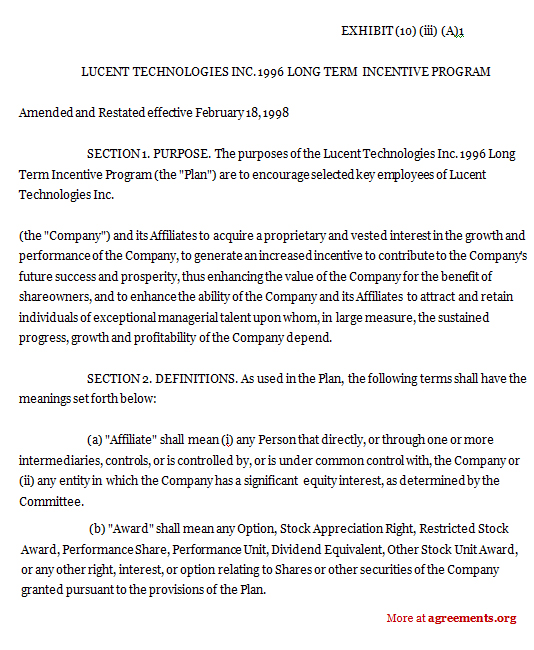A Brief Introduction of Long Term Incentive Plan
Over the years, with more organizations and startups coming up, it has become really difficult for any organization to retain its employees. Employees are constantly looking for better opportunities in terms of money and role, and they are switching fast. A company in today’s time spends a lot of time and money on training a new employee, thus, it always wants to retain its old employees. By retaining the old employees, a company doesn’t have to invest in the process of training. To ensure this, companies have come up with various Long Term Incentive Plans.
There are various examples of Long Term Incentive Plans such as 401k, stock options, sabbatical, cash, vacation increase, equity incentive plans, etc — all parts of employees incentive plans. Each of these management incentive plans has different rules, terms, and conditions. Every company can choose for itself how it wants to implement the plan. The goal, however, remains consistent across all private and government organizations. Another name for Long Term Incentive Plan is Long Term Incentive Program.
When Do You Need the Long Term Incentive Plan?
As discussed above, A Long Term Incentive Program Agreement is needed by the organizations when they are unable to retain their employees. It is also needed when companies want to create a strong financial strategy for themselves. Apart from motivating and retaining employees, these plans also save a lot of tax. Long term plans are different from regular bonus schemes as they provide rewards in 2 to 5 years. Small term bonus plans are also important but they are not as beneficial in the long run as incentive plans because almost every company now implements bonus plans. It should be noted that these plans are important for an organization’s overall growth.
Inclusions in the Long Term Incentive Plan
A standard long term incentive plan template would include the following terms
- Definition of terms involved in the contract
- Administration of the plan and the committees appointed for that purpose.
- Eligibility of the participatns and the method of such selection of the participants
- Determination of incentive compensation and the various plans and awards under various criteria
- Amount of the incentive compensation
- Payment clause including forfeiture and treatment of payment after death
- Waiver of participation
- Designation of beneficiary
- Dissolution of Merger
- Claims for incentive compensation
- Unsecured obligations
- Permissions for transfer
- Taxes and responsibilities for payment of such taxes
- Notices
- Termination of the agreement
- Effective date of amended and restated plan
How to Draft the Long Term Incentive Plan?
When rafting an LTIP, some points you need to consider are
- The purpose for which it is being created
- The cost of administration
- The duration and the right of first refusal
- The criteria for selection of employees
- Communication of the plan
- Clarifying the details of the plan and the process of administration
- Consider the tax implications of the plan
Benefits & Drawbacks of the Long Term Incentive Plan
A well planned and drafted Long Term Incentive Plan doesn’t have any drawbacks for either the company or employee. It only ensures that both parties are benefitting from it. Here are some of the benefits of the plan –
- It protects the interests of the shareholders
- It attracts the best talent
- It brings in better results with the same resources
- It reinforces the company model and the operation process of the company
- It incentivizes employees for better company results which brings in more profits for the company
- It builds trust and trust accelerates good results
- It makes the company’s employee retention rate high
- It inspires the employees to work hard and feel motivated
- It makes the employees feel like they are an integral part of the organization
- It provides tax advantages
- It gives a company a good financial strategy
- It gives reasons to an employee to stick around and plan for a better and secure future
Key Terms/Clauses in Long Term Incentive Plan
The main key terms of an LTIP depend on the type of plan you choose. Some terms in this are
- Details of the incentives
- Eligibility
- What happens after termination of the employee
- Lockin periods for stocks, or any holding compulsory period for the incentive
- Conditions for the incentive
- Confidentiality
- Within the eligible classes, what is the eligibility criteria for the plan
- Open communication channel
What Happens in Case of Violation?
In case of any violation or breach, parties can approach the court. It is suggested that in order to save time and energy, both parties should try to mediate. While making the plan, you should anticipate all the problems that could arise. Provide a dispute resolution method for all the problems so that parties can easily refer to the plan in case of any confusion or doubt. For companies, it is better to never commit a breach as this could destroy the company’s reputation in the market. This will, in turn, do the opposite of what the company had intended to do in the beginning.
As we saw, Long Term Incentive Plans are very crucial for a company’s growth, financial strategy, reputation and employee retention rate. These plans should be designed with a lot of planning and analysis. Long Term Incentive Plan designs for private companies are in demand these days. Focus on Long Term Incentive Plan tax treatment is also very necessary while designing the plan. Here is a Long Term Incentive Plan template designed by our experts.
[Also Read: Incentive Stock Options]
Sample for Long Term Incentive Program Agreement
A sample of the agreement can be downloaded from below.
